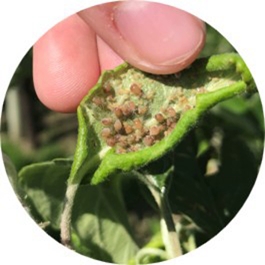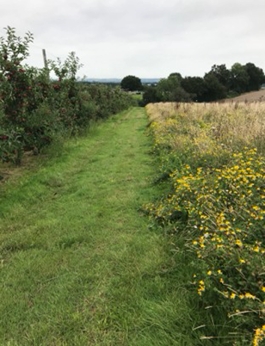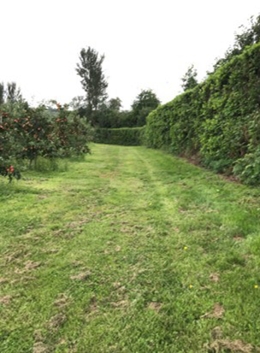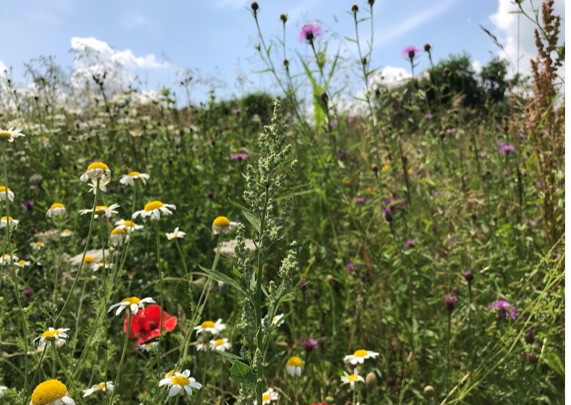

British Apples & Pears Limited (BAPL) R&D meeting 2025.
With colleagues from Niab, the BAPL research and development team hosted a full day of presentations from researchers and experts to share the latest in crop protection technologies and approaches.
More than 80 people joined in person, with a further 150 people joining via the live online webinar.
The meeting took place in Kent on 10th February 2025 and was open to members of BAPL who pay a levy to support this vital R&D work, as well as other interested parties and colleagues from Niab.
In todays world apple growers have less weapons at their disposal for dealing with troublesome pests. Ingenuity and science are the answer. The skills of scientists at NIAB and industry experts search for an environmentally safe answer.
The Challenge of Controlling Hard Bodied Pests in Apples and Pear
 David Hall - Natural Resources Institute, University of Greenwich
David Hall - Natural Resources Institute, University of Greenwich
Michelle Fountain, Celine Silva, Adam Walker NIAB East Malling
Background Due to the reduction in the availability of plant protection products, and some products undesirable due to effects on natural enemies, there has been a resurgence of pests previously controlled by these products, In particular, early-season, hard-bodied pests are becoming increasingly abundant
The search for environmentally sound answers to pests has been successful with predators and/or disruptors now controlling many of the challenges, but as David Hall illustrated, there are many pests still to be dealt with.
Target pests include Rhynchitids, apple sawfly (ASF), apple blossom weevil (ABW) and Anthonomus spilotus

With no pheromones found for these pests so far the aims of this WP are to develop semiochemical attractants that mimic the odour of apple and pear blossoms and spring shoots for combination with visual attractants, these can be used to precision monitor spring pests in the absence of other control options. White sticky traps and tapes are currently used for control of apple sawfly in organic orchards in UK and Europe; their effectiveness could be greatly improved by addition of attractant
Collections of volatiles from intact pear and apple were made from shoots to bloom in the field early collections showed relatively small amounts of predominantly green leaf volatiles from both pear and apple.
Later collections from pear showed larger amounts of (R)-linalool and methyl 2-hydroxy-3 methylpentanoate while Later collections from apple showed predominantly benzyl alcohol SSynthetic compounds will be supplied in suitable controlled-release formulations for testing for attraction of early-season pests to traps in the field.
Collections will be analysed by GC coupled to electroantennographic (EAG) recording from the
antennae of representative early-season pests to check which compounds are detected by the
pests and hence are candidate attractant.
Not all compounds commercially available - need synthesising
Abstract
The way in which organisms detect specific volatile compounds within their environment, and the associated neural processing which produces perception and subsequent behavioural responses, have been of interest to scientists for decades. Initially, most olfaction research was conducted using electrophysiological techniques on whole animals.
However, the discovery of genes encoding the family of human olfactory receptors (ORs) paved the way for the development of a range of cellular assays, primarily used to deorphan ORs from mammals and insects.
These assays have greatly advanced our knowledge of the molecular basis of olfaction, however, while there is currently good agreement on vertebrate and nematode olfactory signalling cascades, debate still surrounds the signalling mechanisms in insects.
The inherent specificity and sensitivity of ORs makes them prime candidates as biological detectors of volatile ligands within biosensor devices, which have many potential applications.
--------------------------------------------------------------------------------------------------------------------------------------------------
Powerful flowers
Charlotte Howard 10 February 2025
Wildflower margins can reduce pests and crop damage
 Rosy Apple Aphids
Rosy Apple Aphids
We wanted to know, to what extent can we reduce rosy aphid damage by adding flower strips to encourage the natural predators?
We know Increasing predator numbers reduces crop pest numbers
So we took two Gala apple orchards per farm, one with a flower margin and one without, ten orchards in total.


We recorded rosy aphids across the whole season, predators in the orchards, weeds in the orchards and fruit damage by rosy aphid - so that we could compare orchards with and without a flower margin.
This was a two year study.
Originally sown with four low-growing fine grasses and 15 perennial wildflowers
Common species found; birds foot trefoil, black knapweed, oxeye daisy, buttercup, dandelion, yarrow, clovers, grasses...
 Flower margins: High aphid presence one year (65% & 25% of trees damaged) but showed different effects each year
Flower margins: High aphid presence one year (65% & 25% of trees damaged) but showed different effects each year
reduced the number of rosy aphids on infested trees and reduced the number of trees with damaged fruit (from 80% to 50%)
up to 50m from the flower margin - Weeds did not spread.
Flower margins:
Cost/benefits also varied between years, economic net benefits for headland margins. modelled predictions - not published yet
What does it mean?
First economic analysis with control, more studies needed to confirm flower margin studies - crop damage.
Promising results regarding fruit damage & financial benefit, there are wider potential benefits. Other pests, improved pollination and reduced pesticide requirements.
![]() That is all for this week
That is all for this week
Take care
The English Apple Man